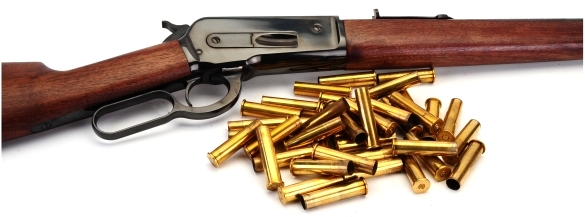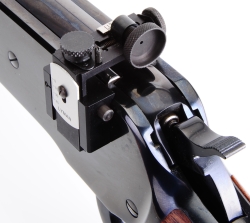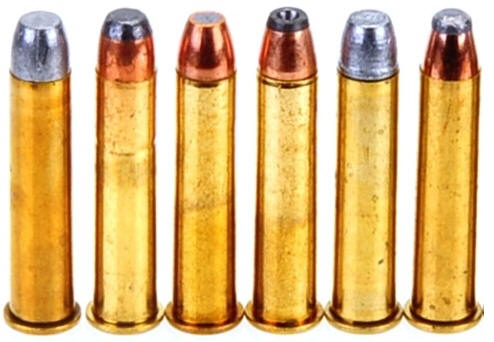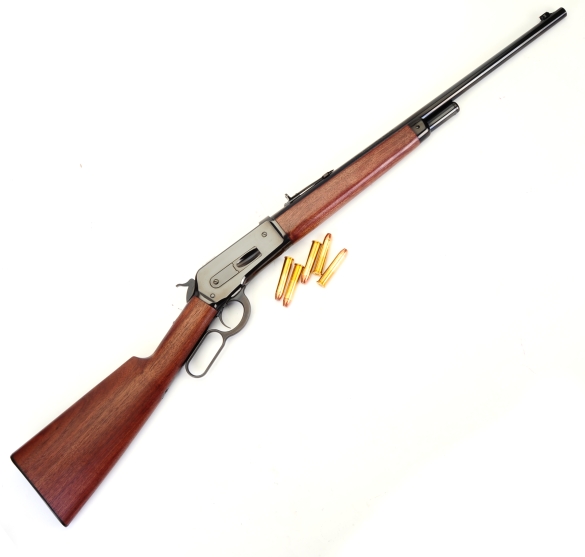
Usually I open a box, take out a new firearm and get excited about the possibilities of the associated project. About the 323rd time I pick it up, I am thinking about lunch, the tiny hole in my sock and wondering how the NY Giants will again fail me in an upcoming game. It’s human nature. This time, I am happy to say that the Part 1 infatuation with the Winchester Model 1886 has not subsided.
Some quick comments followed before pressing on

Groups were shot with the factory period correct buckhorn sight and with the Lyman Peep sight pictured. After three sets it became apparent that, for me, the peep sight cut group sizes nearly in half at fifty years so it was left in place for data collection. Not a condemnation of the factory sights, but rather a statement regarding my mature eyesight.
The factory front blade sight’s height worked well with both types of rear sights. By removing the elevator from the buckhorn sight, it dropped below the peep sight’s horizon and did not obscure view of the front sight even with the peep sight adjusted all the way down. The 0.040″ target disk remained in place throughout.
There is a good deal of bad information on the Internet. Some folks taught their little boys and girls that they are “special” and that their foundationless message board parroting counts as much as opinion based upon first hand experience, comprehension of the subject and/or objective measurement. My favorite recently read comment stated that the 45-70 Gov’t is a pistol cartridge that could be effective for deer hunting as a rifle round, but only inside fifty yards. The exterior ballistics table below, generated with the Real Guns Exterior Ballistics Calculator shows a maximum ordinate of +3″ and a point blank range of 204 yards with a 175 yard zero. The ton of 200 yard terminal kinetic energy isn’t bad for a bullet that is, essentially, a flying barn door.
|
Indices |
Buffalo Bore 350 grain Load | ||||
| Range -yds | 0 | 50 | 100 | 150 | 200 |
| Velocity – ft./sec. | 2205 | 2038 | 1879 | 1728 | 1586 |
| Energy – ft.-lbs. | 3778 | 3228 | 2744 | 2320 | 1955 |
| Path – in. | -1.5 | 1.8 | 3.0 | 1.7 | -2.5 |
| Time of flight – sec. | 0.0 | 0.1 | 0.1 | 0.2 | 0.3 |
The 45-70 Gov’t, in most any form, is a superb cartridge. Performance of ammunition can range from modest smokeless powder loads that duplicate the ballistics of the original 1873 .45-70 Government black powder round; roughly a 405 grain bullet with a muzzle velocity of 1,300 fps, up to more modern loads that scoot 405 grain bullets along at 2,000 fps+ for 3,500 ft/lbs+ of muzzle energy. Cast or jacketed bullet, and regardless power level, the 45-70 Gov’t has a history of long range accuracy that includes 1,000 yard range competitive target shooting. For handloaders, the 45-70 Gov’t is one of the best, however, current factory ammo can perform nearly the same, but at a significantly higher cost.
Factory Ammo

For the most part, the performance of good handloads for the 45-70 Gov’t can be duplicated with factory ammunition that is available to everyone. What would be missing with factory ammunition would be unique combinations of components, hand finessed quality and lower cost. SAAMI standard Maximum Average Pressure by transducer measurement for the 45-70 Gov’t is 28,000 PSI and, just like all other manufacturers of firearms chambered for this cartridge, Winchester recommends ammunition that is dimensioned and functions within SAAMI specifications.
Numerous manufacturers make higher than standard pressure ammunition, often labeling the product as “+P”. Unfortunately, there is no +P SAAMI standard for the 45-70 Government, which suggests the labeling and criteria are the under the control of the individual ammunition manufacturer. This doesn’t mean this ammunition is bad or dangerous, only that there is no standard for testing or certification. Subsequently, it would be difficult for a manufacturer to officially approve the use of this type of ammunition; not politics, just integrity.
Table below, rows ordered as pictured above L-R. The 18.5″ barrel data was collected from an 1895 Marlin Guide Gun and shown as performance reference with the 22″ barrel Winchester Model 1886.
|
Winchester Model 1886 Extra Light Rifle 22″ barrel |
||||||
|
Ammunition |
Bullet Weight |
50 Yard 3 Shot Group “ |
22″ Barrel Muzzle Velocity FPS |
22″ Barrel Muzzle Energy Ft/Lbs |
18.5″ Barrel Muzzle Velocity FPS |
18.5″ Barrel Muzzle Energy Ft/Lbs |
| Black Hills | 405 | 0.8 | 1207 | 1310 | 1204 | 1304 |
| Remington Express | 405 | 0.5 | 1251 | 1408 | 1175 | 1242 |
| Winchester Partition | 300 | 0.6 | 1759 | 2062 | 1636 | 1783 |
| Winchester Super X | 300 | 0.7 | 1846 | 2271 | 1648 | 1810 |
| Buffalo Bore* | 430 | 0.9 | 1953 | 3643 | 1886 | 3397 |
| Buffalo Bore* | 350 | 0.6 | 2205 | 3780 | 2127 | 3517 |
| * Marketed as +P ammunition | ||||||
The 45-70 Government does not typically need a very long barrel to deliver solid performance. In this case, with the exception of the low pressure standard factory duplicating ammunition, there were some significant gains that came with the 3.5″ barrel length increase. Because most 0.458″ bullets are heavy, and because kinetic energy increases exponentially with increases in velocity, even modest increases in velocity can make a big difference in kinetic energy. As an example, the Winchester Super X gained 198 fps with the 1886, or about 400 ft/lbs greater muzzle energy.
Shooting and operation impressions
 This, 0.7″ center to center 50 yards three shot group is typical, but a number shot with 1″ gridline targets were significantly smaller. If there was anything notable, it would be how easy it is to shoot the Winchester accurately with the aperture sight.
This, 0.7″ center to center 50 yards three shot group is typical, but a number shot with 1″ gridline targets were significantly smaller. If there was anything notable, it would be how easy it is to shoot the Winchester accurately with the aperture sight.
The Model 1886 is not without a… spirited personality, however, the wide buttstock did a good job of dampening felt recoil. The straight stock geometry kept muzzle climb in check, which made for fast follow up shots. Few targets got away.
At the beginning of the range session, I short stroked the lever a couple of times and missed chambering a fresh round. That operator error went away as soon as I got use to the feel of the carrier raising a loaded round and I remembered how to shoot a lever action rifle. The Winchester is put together really well. Extraction, ejection and feed are very smooth. Loading the Model 1886 is an easy proposition with no thumb cuts on sharp loading gates or uncooperative cartridge rims. The tang safety is handily placed and easy to actuate and I do like them better than a cross bolt safety.
Overall
The Winchester Model 1886, looks like a rifle, feels like a rifle and shoots like a rifle. I’m jaded. I handle so many firearms during the course of a year that I sometimes forget the content of a past review and my impressions of a particular rifle. Not the case here. My first impression was how perfectly new this rifle was when it was removed from it’s box. No scuffs, scrapes, handling marks or areas of uneven finish, the Winchester was flawless, both deeply blued hardware and satin finished walnut pieces. The product of a company that has a respectful view of its customers and pride in its product. It is a shooter; accurate, lots of power and just about right in weight for the cartridge it chambers.

The paths of John Browning and Winchester crossed many times. I couldn’t think of a better historical example of the result that collaboration than this Model 1886 Extra Light Rifle. For further information on the Model 1886 and other quality Winchester firearms, drop by Winchester’s Web site.
Winchester’s Model 1886 Extra Light Rifle Part 1
Winchester’s Model 1886 Extra Light Rifle Part 2

Email Notification